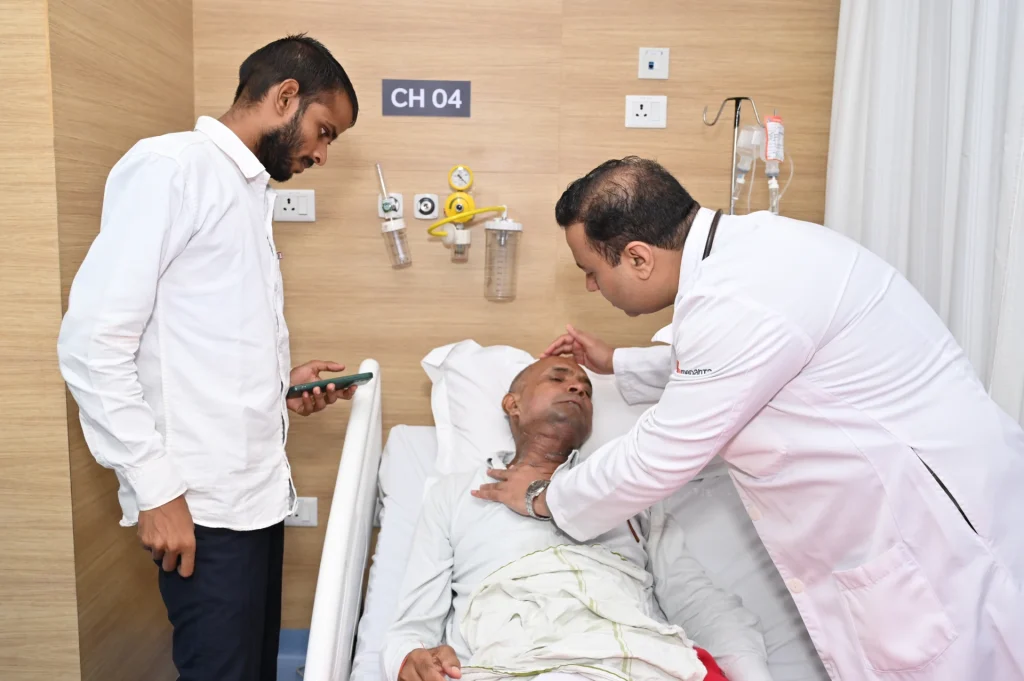- CANCER HELPLINE: 1800-22-1951
- 91 7317418888
- contact@drharshatreya.com
- CANCER HELPLINE: 1800-22-1951
carousel-slider domain was triggered too early. This is usually an indicator for some code in the plugin or theme running too early. Translations should be loaded at the init action or later. Please see Debugging in WordPress for more information. (This message was added in version 6.7.0.) in /home/locaqain/public_html/drharshatreya/wp-includes/functions.php on line 6121Breast Cancer is a common cancer that begins in the breast cells, and it’s one of the most prevalent cancers affecting women globally, though men can develop it too. Early detection and advances in treatment have significantly improved survival rates and quality of life for many patients.
Sometimes the cancer does not spread any further. This is called “in situ.” If the cancer spreads outside the breast, the cancer is called “invasive.” It may just spread to nearby tissues and lymph nodes. Or the cancer may metastasize (spread to other parts of the body) through the lymph system or the blood.
Trained and educated at the best medical institutes of India – All India Institute of Medical Sciences (AIIMS), and Cancer institute, Adyar, Chennai.

Breast cancer is one of the most common cancers affecting women worldwide, although men can also develop it in rare cases. It occurs when cells in the breast begin to grow uncontrollably, often forming a lump or mass, which can be detected through self-exams, mammograms, or clinical exams. While not all lumps are cancerous, those that are malignant may invade nearby tissues and spread to other parts of the body if left untreated.
There are several types of breast cancer, the most common being invasive ductal carcinoma (IDC) and invasive lobular carcinoma (ILC). IDC starts in the milk ducts and can spread to surrounding tissue, while ILC originates in the milk-producing glands. Other types include inflammatory breast cancer, which is aggressive and can cause the breast to become red and swollen, and triple-negative breast cancer, which lacks three common receptors used in targeted therapies, making it more challenging to treat.
Several risk factors are associated with breast cancer, some of which are genetic and others related to lifestyle. Family history, age, gender, and inherited gene mutations, such as BRCA1 and BRCA2, can increase the risk. Lifestyle factors, including diet, alcohol consumption, smoking, and physical activity, also play a role. Early menstruation, late menopause, and hormone replacement therapy can increase risk due to prolonged exposure to estrogen.
Early detection is critical for successful treatment. Regular self-exams, mammograms, and awareness of changes in the breast can aid early diagnosis, improving treatment outcomes. Treatment options vary depending on the cancer’s stage, size, and specific characteristics. They include surgery (lumpectomy or mastectomy), radiation, chemotherapy, hormone therapy, and targeted therapies. The choice of treatment often involves a personalized approach, balancing effectiveness with potential side effects.
Early diagnosis is critical for successful treatment, and there are several methods used to detect and diagnose breast cancer:
Mammography: A low-dose X-ray of the breast that can detect tumors or abnormal areas before symptoms arise. Recommended regularly for women over 40.
Ultrasound: Often used to differentiate between solid lumps and fluid-filled cysts.
Magnetic Resonance Imaging (MRI): Uses magnetic fields to create detailed images, especially useful for high-risk patients.
Biopsy: A sample of breast tissue is taken for analysis, which confirms the diagnosis and type of breast cancer. Types include fine needle aspiration, core needle biopsy, and surgical biopsy.
Molecular Testing: Determines the presence of hormone receptors (estrogen and progesterone) or HER2 protein, guiding treatment choices.
Treatment plans for breast cancer are individualized, often involving a combination of therapies:
Surgery:
Lumpectomy: Removal of the tumor and a margin of surrounding tissue, preserving most of the breast.
Mastectomy: Removal of the entire breast; can be simple or radical, depending on cancer spread.
Sentinel Node Biopsy: Removal of the first few lymph nodes to which cancer would spread.
Axillary Lymph Node
Dissection: Removal of multiple lymph nodes in the underarm area.
Radiation Therapy: Often used after surgery to destroy any remaining cancer cells, reducing recurrence risk. It targets the breast, chest wall, or lymph nodes.
Chemotherapy: Uses drugs to kill or inhibit cancer cell growth, often given before surgery (neoadjuvant) or after (adjuvant). Common drugs include doxorubicin, cyclophosphamide, and paclitaxel.
Hormone Therapy: For hormone receptor-positive breast cancers, drugs like tamoxifen and aromatase inhibitors (anastrozole, letrozole) block hormones that fuel cancer growth.
Targeted Therapy: Targets specific proteins in cancer cells. For HER2-positive cancers, drugs like trastuzumab and pertuzumab are effective.
Immunotherapy: Used for triple-negative breast cancer, immunotherapy drugs like pembrolizumab help the immune system attack cancer cells.
© 2024 Harshvardhan Atreya. All Rights Reserved.